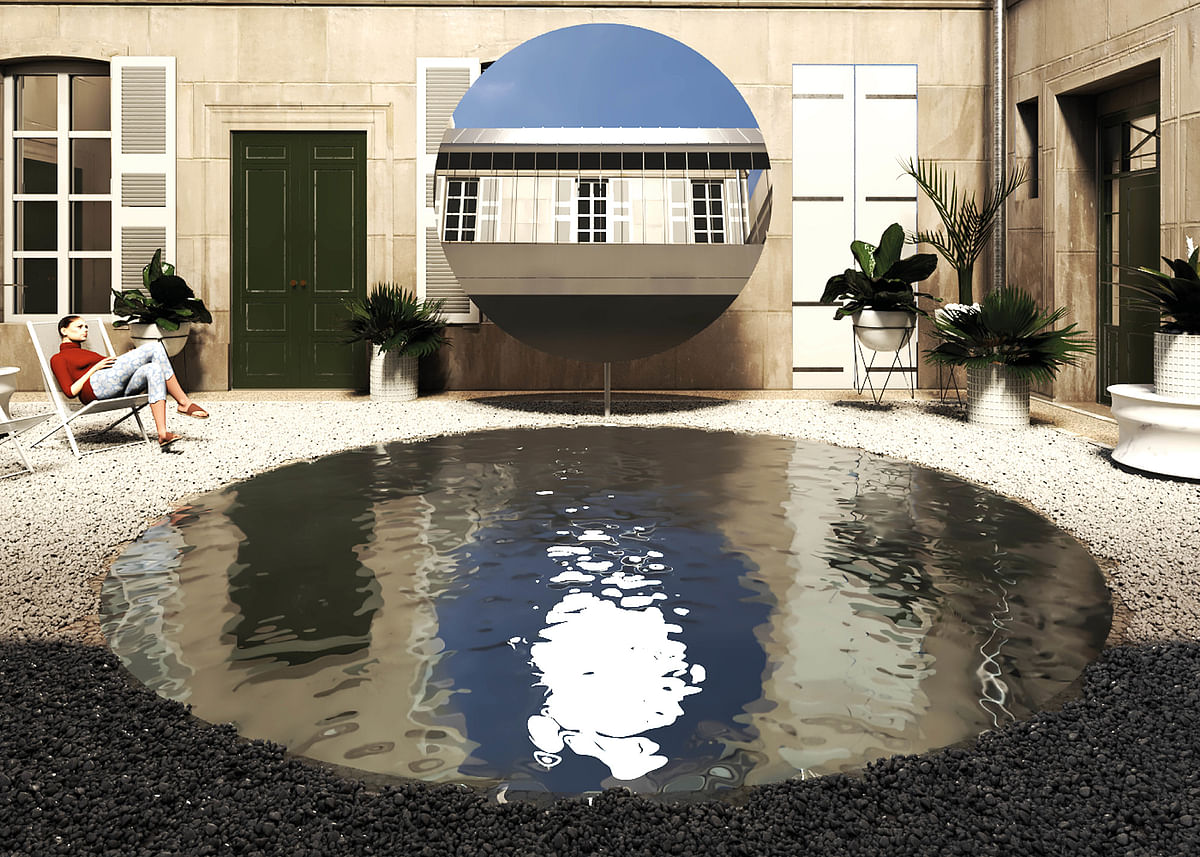
2018 Festival des Architectures Vives reveals 10 “SENcity” art installations
By Justine Testado|
Monday, Mar 12, 2018
Related
Every year during the summertime, visitors and locals alike flock to the historical city center of Montpellier for the Festival des Architectures Vives. The weeklong exhibition comprises of site-specific, public art installations that connect private mansions and courtyards typically closed off to the public. The 2018 festival takes place June 12-17.
Things have gotten more technical in the FAV's 2018 theme, “SENcity” in that it explores the impacts of the present-day “smart city” and the significant contributions of emerging technologies to urban living. Ten emerging architecture teams plus a team representing the University of Genoa School of Architecture were invited to design an interactive installation that interprets this theme. Planning on going? Scroll down to see what each installation will look like and its location.
“Complicity” by Mailys Meyer and Camille Vannier
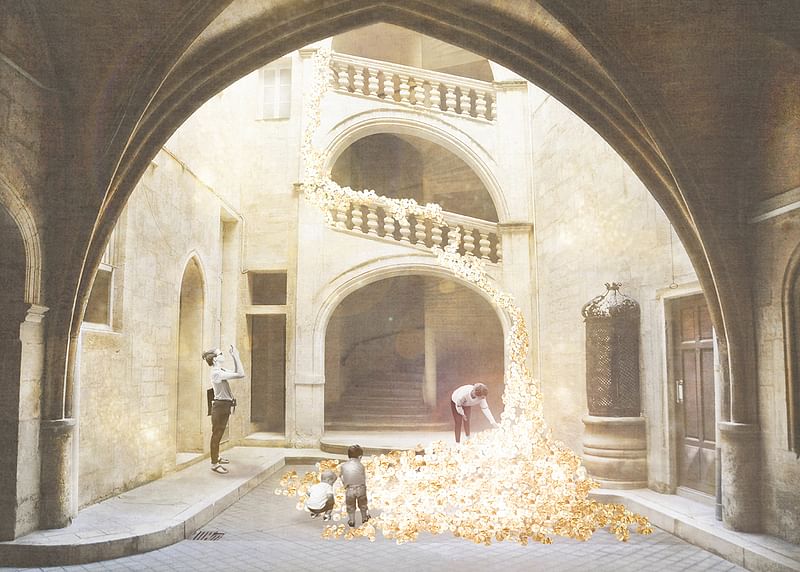
Location: Hôtel de Mirman, 7 place du Marché aux fleurs, 34 000 Montpellier
Project summary: “Welcome to our shared garden. We invite visitors to come in pairs and lay down a flower, contributing to this under-construction landscape. While sensitive and delicate, the artwork is ultimately ever-changing and interactive, embodying the idea of the smart city. The image of the flower recalls the Marché aux fleurs plaza, located in the heart of this neighborhood. Flowers are also fragile and ephemeral, like the information that feeds Big Data. Visitors are encouraged to share, like, hashtag, and geo-locate their contribution to the work on social networks, creating a digital record of the installation. The end result is a field of flowers a product of the participation and meeting of actors, sensitive to their environment and its enhancement.”
“Nature électrique” by 1 week 1 project
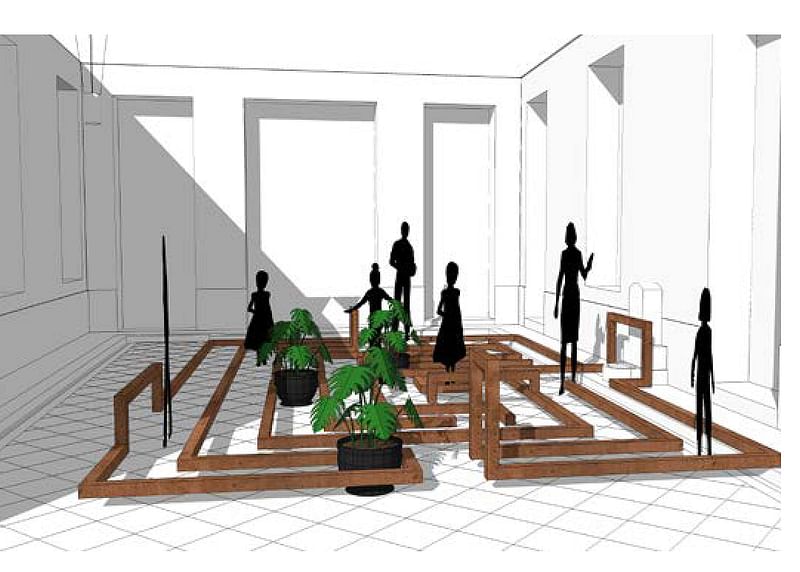
Location: Hôtel du Palais des Guilhem 12 rue du Palais des Guilhem 34 000 Montpellier
Project summary: “Nature Electrique is an interactive labyrinth where the visitor is lost in a wooden installation tattooed with electric paint. The material reacts to the touch with sound reaction, the wood is transformed here into a real «sensitive pad». The interactions act as landmarks in the «forest» helping the visitor to find his way. Attached to our connected devices, we accumulate a certain amount of data every day. Where do all this information go? How to deal with it? Nature Electrique wants to show this fear of the Big Data by literally losing the visitor. The sound interaction will focus on the theme of water with recordings from the Pacific and Atlantic Oceans. With the electric paint, the project intends to be educational demonstrating that any element can now become conductive.”
“Summit” by Miguel Angel Lopez Carro & Alberto Vallejo Puntero
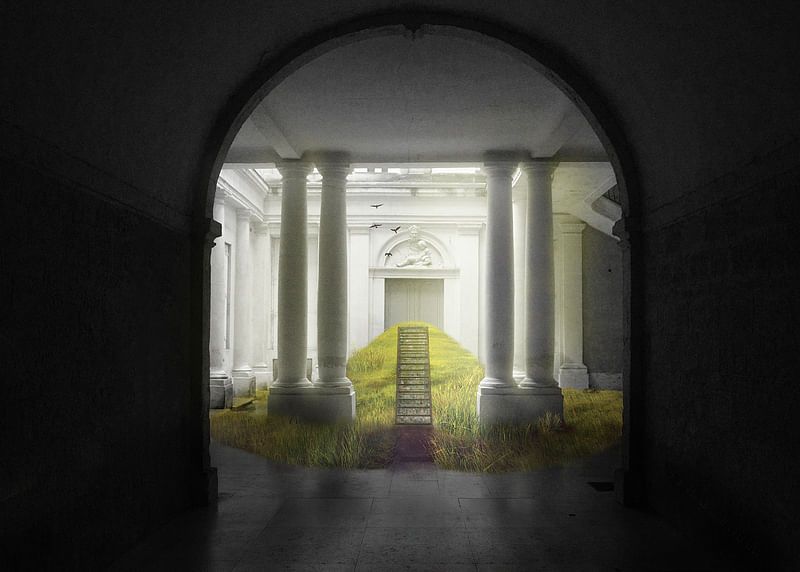
Location: Hôtel de Griffy, 26 rue de l’Aiguillerie, 34 000 Montpellier
Project summary: “The smart city is the one responsible and aware of the waste it generates. It is the city that recycles, reuses and reinvents itself. It is resilient, and sees an opportunity in a problem to take advantage of and improve. Summit rises as a reaction to human destruction of the environment. Due to energy consumption, new technologies and actual lifestyle, the production of waste exceeds the earth capacity to recover them. Growing on residues, a green carpet over the artificial pavement fills the courtyard, covering the mountain of plastic residue. Inspired by natural and organic forms, the topographical alteration establishes a new viewpoint for the visitor. A natural expression flourishes on top of a human creation.”
“U.S.I.N.E - Unité Symbiotique Intelligente Naturelle Efficiente” by Louis Caux and Margaux Limon

Location: Hôtel de Rozel, 2 ter rue Saint Pierre, 34 000 Montpellier
Project summary: “If Many technological advances are inspired by world of living sciences, this biomimetic production leads us to a critical point where humans threaten their future by degrading their source of inspiration. At the heart of SENcity, the living world is recognized as the cutting edge of technology. Some newly-named industries U.S.I.N.E appear in the interstices of the city. When entering the Rozel courtyard, a green mass captures the attention of the visitor, perhaps is it a garden? No, it’s a micro-industry that opens its doors. Far from the din of machines, the U.S.I.N.E operates in all discretion: purification; filtration; depollution; production of biomass, energy and food. Creating a micro-climate, it improve the living environment, promote urban refreshment and contribute to the development of social bonds. Here the installation invites us to wonder about man position in his technological environment.”
“Miroirs Miroirs” by 2PAC - Arthur Biasse, Clémentin Rachet, Paul Gard-Baholet and Pauline Le Biez
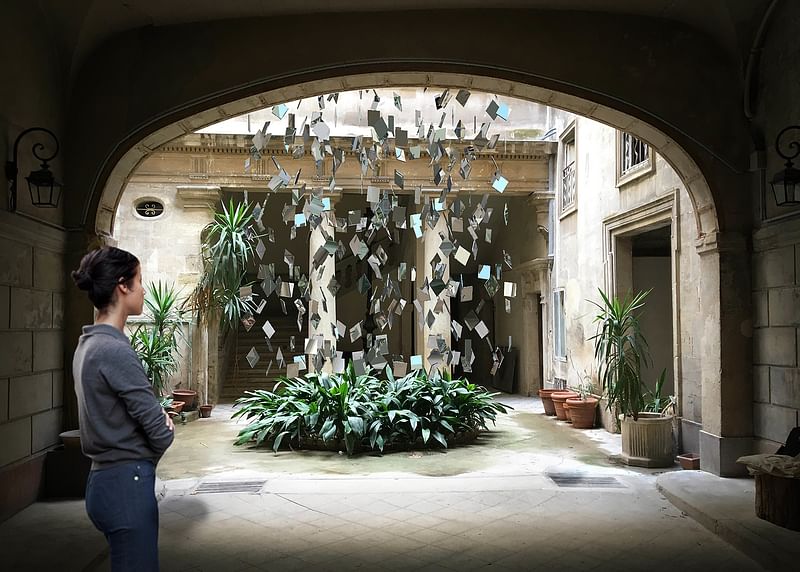
Location: Hôtel d’Hortoles, 15 rue des Trésoriers de la Bourse, 34 000 Montpellier
Project summary: “Many stakes are carried by the part of technological devices in the appreciation of urban issues : time has come for architects to include these issues within their creative processes. In the light of a unique architectural background, as well as historical, the courtyard of the Hôtel d'Hortoles led us to wonder how these technological tools could magnify the heritage of such a place, while developing interactions with the visitors. In order to fulfill these high expectations, our project consists in an environmental and contextual device, based on a fall of revolving mirrors, hanging on cables in the center of the courtyard. Upon the four facades of the courtyard, solar collector boxes will generate the rotating movement of the shrouds, following the curve of the sun. Visitors will thus feel the natural benefits of the sunlight, the cornerstone of the Montpellier climate. Our project twists and celebrates the architectural heritage through an ecological and interactive installation.”
“Stories” by Floating fantasy - Noel Picaper and Hugo Bertrand
Location: Hôtel de Baudon de Mauny, 1 rue de la Carbonnerie, 34 000 Montpellier
Project summary: “Strange white figures appear like ghosts in the hotel courtyard. They seem at first sight to be abstract and smooth but tiny translucent creatures with fantastic colored shapes are living on them: the data. They stand there as time immemorial and draw the lines of extraordinary stories that we are unable to understand. How can we decrypt their language ? By which means can we comprehend these arrangements whose invisible scale surprises us ? ‘ Stories ’ introduces a new level of reference in Montpellier. It is a microcosm which takes shape on the rough extension of the earth and forms impalpable digital connections. The lilliputian size of the data highlights a certain poetic of miniature. The insignificant gains sense. A first elusive reading is possible. Then technical tools (smartphone, camera, video camera…) allow another glance. After some contortions and crouchings the figure of every small creature appears to us as our devices pick them up. A world of microstories reveals itself and the electronic picture brings it into focus. Each viewpoint is unpredictable and/ or subjective. In this way new situations may be continuously imagined which encourage individuals to share their discoveries. ‘ Stories ’ is the tangible representation of endless opportunities and operative choices which are formed by the evocative power peculiar to small and imperceptible things.”
“DataLoop” by No Boundary Design - Ken Lee, Ioannis Kamaretsos, Martin Lutz
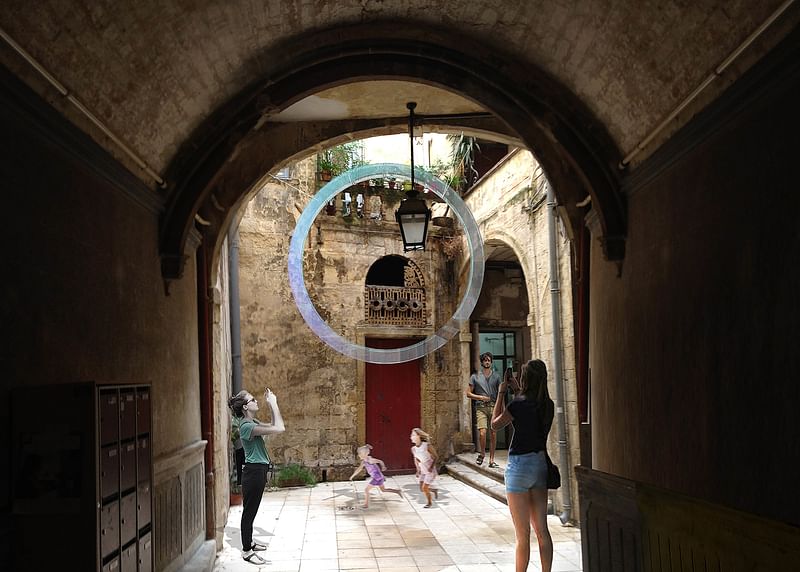
Location: Hotel de la Petite Loge, 10 rue de la Petite Loge, 34 000 Montpellier
Project summary: “Technology empowers us, but without doubts, it comes with a few side effects. To us the loading ring ( a.k.a Throbber ) is an accurate analogy to represents the love and hate relationship between human and technology. Throbber was first introduced in the early 1990s to replace the busy looking hourglass and informative loading bar in order to create a visual indication that the programme is performing in action. Disguised beautifully in a spectrum of color moving in circular motions, Throbber is a well-decorated excuse for consuming our valuable time on a very frequent basis. It seems that the evolution of technology fails to get rid of Throbber in the last 30 years. The reasons for its existence vary from the incompetence of hardware and software, viruses, irresponsible users behaviors…etc. and it mainly has to do with the human desire to create faster, thinner, bigger, clearer, better technologies and experiences. And standing from today’s perspectives, this appears to be an endless loop, and therefore it is predicted that Throbber will always be there regardless how advanced technologies will become.”
“Jeu de Formes, Forme de Jeux” by (hexa)gones - Anaïs Cornu, Logan Rainon et Marion Rhodes
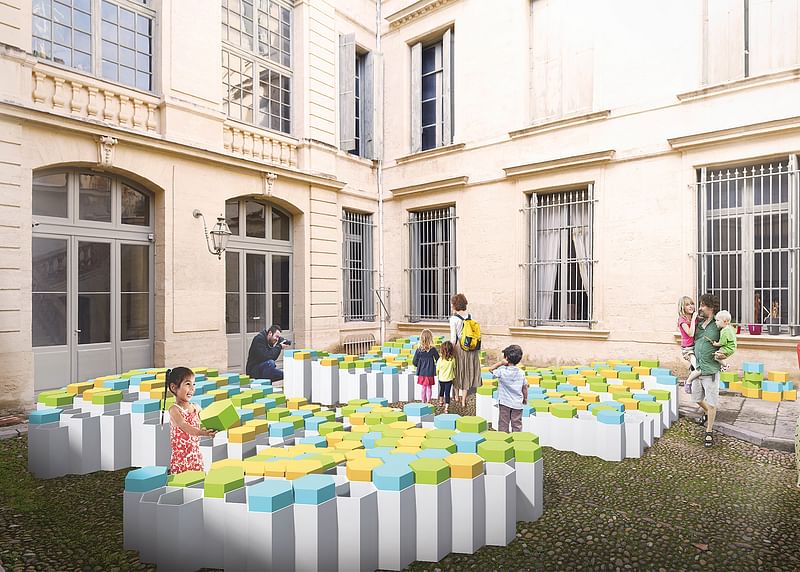
Location: Hôtel de Lunas, 10 rue de la Valfère, 34 000 Montpellier
Project summary: “Technology is more than a simple tool. It allows exchanges and a new way to experience and conceive the city.
How technology is at the core of next generation city ?
And what can be humanity’s contribution on this path ?
In answer, we choose to create an interactive honeycomb shape structure, symbolising the « big data ». We all bring with us a diverse knowledge. Our structure gathers this diversity. The wave of the structure create a new topography in the flat space of the courtyard. This extra layer is a contribution to a new way of thinking the city. Each one of us can influence this whole project and get involved in its manufacture.”
“Black network” by Aude Lise Garcia, Jordan Llanos and Valentin Sambardy

Location: Hôtel d’Aures, 14 rue Eugène Lisbonne, 34 000 Montpellier
Project summary: “The architectural design of our installation was to formalize metaphorically the impact of the data exchanged through the network. A mesh of rope diffusing through the entire courtyard shapes this idea. Concurrent with the exponential propagation that the network has in our lives, the strings are, here, the reinterpretation of the multitude of data that we send across the “Network”. The strings will have different colors depending on the origin of the data sent: Finance, Social Networks, Ecology… The installation goes through several phases. First, the visitor enters the network, then throughout its progression; he will be oppressed until he bends, against his will, under this heavy mesh. The visitor is thus forced to give in to “this technological pressure”. There is only one possible exit: free himself from this network to become aware of the real world. This allows to highlight the inner courtyard. A whole universe then takes form and immerses the visitor between reality and fiction. The shade here comes to disrupt the senses.”
(cover image) “Troiscentsoixante” by Judith Busson Taridec, François Cattoni, Camille Jeanblanc, Yoan Brazy

Location: Hôtel Audessan, 9 rue de la Vieille Intendance, 34 000 Montpellier
Project summary: “In a place isolated from space and time in which we progress everyday, it is about leading an experience. The urban human being experience, isolated in a environment which fills artificially its physiologic needs in light. A mirror laying on the floor is an ode to the sky to the one who looks at it, while the one above is a call to lights. Temperature, light, reflections, shadows, the association of the two of them allow to live a game in which the search of sun beams remind to the player this sensorial experience of exposing the human body to the sun and how much this experience is missing in certain places and situations. regarding the festival, this game of reflections brings a new perception of the architecture. It invites to take a step back and open the path to an innocent look at surrounding areas and peers, to a deep diving in a new world, to a moment of contemplation.”
RELATED EVENT Festival des Architectures Vives #FAVMTP2018


Share
0 Comments
Comment as :